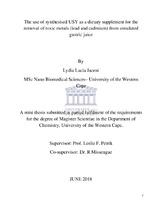| dc.description.abstract | The South African economy relies heavily on mining. The residues of these activities contain
harmful metals that are discharged into the environment as industrial wastes, contaminating
the air, soil, surface and ground water. A lot of people who live in remote areas in South Africa
rely on ground water to drink and cook. They also cultivate their own vegetables increasing the
risk of metal toxicity. Some of these metals are very toxic and can cause adverse effects upon
being ingested.
Toxic metals are well known to be harmful to humans. Some of these metals are carcinogenic
or nephrotoxic when a large amount is accumulated in the human body causing cancer and
destroying tissues such as the kidneys. The detrimental health effects of these metals may take
months to years before manifestation causing people to sideline them as hazards. One of the
major toxic elements that are discharged into the environment is lead.
A natural zeolite called clinoptilolite has been widely used as an adsorbent for toxic metals from
contaminated water and from the human body because of its properties such as ion-exchange
capacity and pore size. However, this natural zeolite clinoptilolite is not pure and may contain
traces of toxic elements of which the nature and concentration depend on the origin of
clinoptilolite. The structural stability of clinoptilolite in acidic or alkaline media is not well
documented. The lack of documented information about the leachates of clinoptilolite and
their long term effects on the human body may cause harm to people who ingest this zeolite.
This has led to investigation of synthetic zeolites such as faujasite which has already been used
for decontamination of sludge, industrial effluents and other waste water by removing toxic
metals such as Pb, Cd, Cu, Zn and As. This study focuses on comparing the toxic metal removal
efficiency of natural zeolite clinoptilolite (C), clinoptilolite-based faujasite (FAU3) and
clinoptilolite-based ultrastable Y zeolite (USY3), from contaminated water and simulated gastric
juice containing lead and cadmium and to evaluate the extent of leaching of other elements
from these zeolites.
Clinoptilolite was used as a starting material for the synthesis of faujasite (FAU3) which was
further treated with oxalic acid to get an ultrastable Y zeolite (USY3). Various techniques were
used to characterise the as-received clinoptilolite, faujasite zeolite and USY, namely XRD, SEMEDS,
FTIR, solid state NMR (27Al and 29Si) and BET-N2. These characterisation techniques
confirmed that clinoptilolite was successfully transformed into faujasite and that the treatment
of faujasite with oxalic acid yielded USY3. A comparative adsorption study was conducted using
three zeolite samples: namely Clinoptilolite (C), clinoptilolite-based faujasite (FAU3) and
ultrastable Y zeolite (USY3). ICP was used to characterise the liquid samples and it was
concluded that zeolites were efficient in removing lead and cadmium from contaminated water
samples as well as from simulated gastric juice. Some leachates from these zeolites were also
observed.
A contaminated water sample containing lead and cadmium was used as a medium where the
removal capacity and percentage removal with C, FAU3 and USY3 was investigated. It was
observed that the optimum dosage varied from one zeolite to the other and also from one
metal to the other. The optimum dosage for C, FAU3 and USY3 for the uptake of lead was found
to be 0.2 g, 0.2 g and 0.05 g respectively while for cadmium it was 0.4 g, 005 g and 0.1 g,
respectively. It was also shown in this study that the removal capacity for lead and cadmium
could be hindered by the Na content in FAU3 and USY3 due to the fact that these metals could
be in an uptake competition with Na and other cations that leached out or exchanged from the
zeolites. It was observed that the optimum metal concentration for lead uptake as well as for
cadmium with few metals being released back into the solution was 0.1 mg/L. The optimum
contact time for both lead and cadmium was 15 minutes. The factor that varied depending on
the type of metal was pH, which was at its optimum at 3.5 for lead and at 5.5 for cadmium.
A simulated gastric juice was contaminated with toxic metals (lead and cadmium) and the
zeolites were used to treat the contaminated samples. It was shown that the removal capacity
of these zeolites increased with the increase in initial concentration of the metal. Time proved
to be one factor that affected the behaviour of zeolites. The modification of the synthesised
faujasite into an ultrastable Y zeolite proved to have played a role in increasing the removal of
toxic metals and in preventing the high leaching of some elements out of the zeolite. | en_US |

